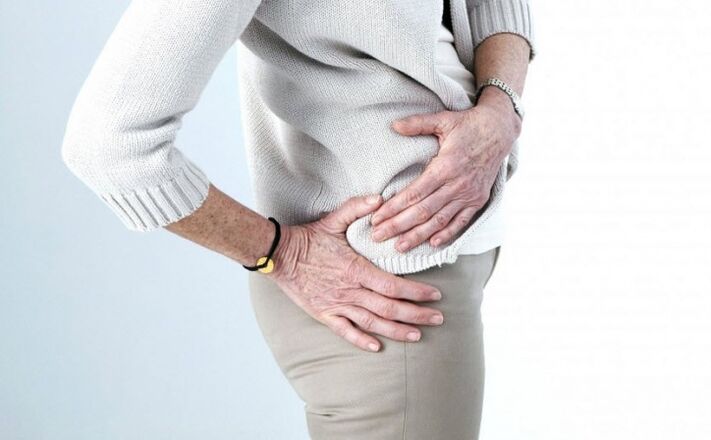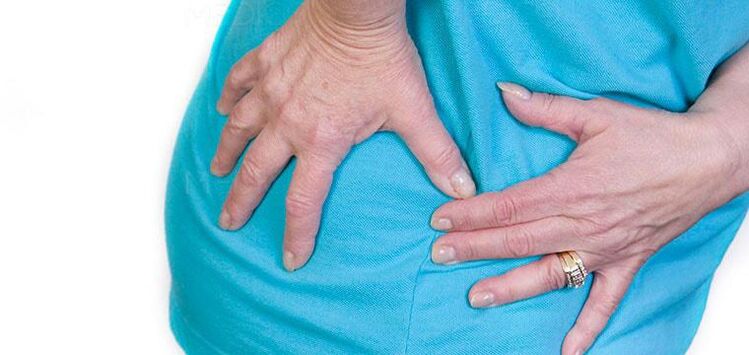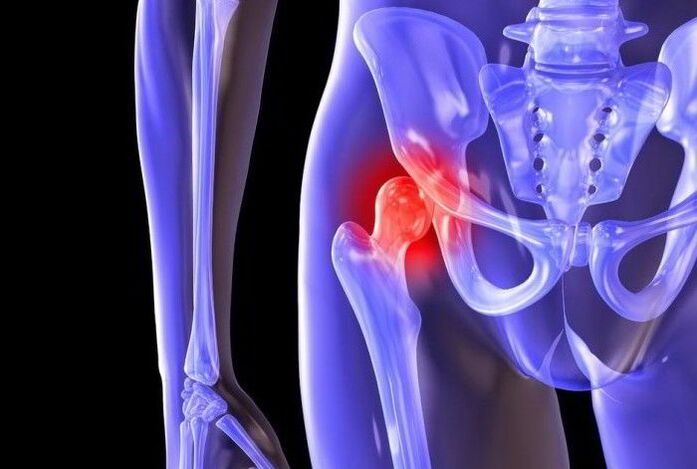Coxarthrosis of the hip is a complex process of degenerative dystrophy.The disease has a fairly wide spectrum of clinical manifestations and is predominantly characteristic of people over 40 years of age, but can also be diagnosed at younger ages, particularly in children and adolescents.

Often, the precursors to coxarthrosis in the hip are various types of trauma and inflammation that are poorly or inadequately treated.
There are several stages of development of the degenerative dystrophic process, each of which requires a specific direction of complex therapeutic approaches.
What is coxarthrosis of the hip?
Hip joint or hip joint/deformed joint is a complex pathological disease of the largest joint in the human body, accompanied by the progressive destruction of osteochondral tissue.The development process is gradual.
Late diagnosis and lack of appropriate treatment can lead to deformation of adjacent bone surfaces and bone growth, limiting mobility and interfering with normal human life.
Statistics show that this type of disease occurs in 12% of cases diagnosed pathologically in the musculoskeletal system.
Causes of Hip Arthropathy
Today, it is customary to distinguish between two types of coxarthrosis of the hip:
- primary, whose occurrence is unexplained;
- Second, it develops in the context of other existing diseases.
With primary hip arthropathy, concomitant pathologies of the musculoskeletal system are often observed, including osteochondrosis of various parts of the spine.
The most likely reasons are as follows:
- Pathologies of the development of the musculoskeletal system (dysplasia);
- Aseptic necrosis of joint tissue;
- infectious disease;
- Inflammation and infectious diseases;
- Injuried.
risk factors
Among the factors that increase the risk of developing hip arthropathy, often emphasis is placed on:
- Systematically increase load;
- Poor circulation within joint tissues;
- hormonal changes;
- Metabolic disorders;
- natural aging;
- The lifestyle is not active enough.
It is noteworthy that hip joint disease itself is not heritable; therefore, people with such a diagnosis do not have a genetic predisposition; however, the manifestation of genetic factors can be observed as other features of body functions that trigger the development of the pathology.Characteristics of this type include metabolic disorders, special structure of the musculoskeletal system, and weakness of joint tissues.
Degree of hip joint disease
Like any other pathology, degenerative dystrophic diseases have degrees of progression.There are only three types of hip arthritis, and each is characterized by certain changes.
Grade 1 hip arthropathy
In grade 1 hip arthropathy, a relatively modest narrowing of the joint space is observed, accompanied by growth of bone tissue across the entire joint surface.
There were no pathological changes on the femoral surface.
2nd degree hip arthropathy
For grade 2 hip arthrosis, the gap between the joint bones is significantly narrower, more than 50% smaller than the generally accepted index.The pathological process leads to displacement of the femur, accompanied by deformation of the femoral head, which significantly increases in size and is covered with numerous irregularities along its contour.
During this stage of development, bone growth occurs on all surfaces of the acetabulum, not just cartilage.
Hip arthritis grade 3
Third-degree hip arthropathy is characterized by sharp deviations in functional indicators and a substantial reduction in the space between the articular bones.Additionally, the femoral head is significantly expanded and there is substantial bone growth.
Symptoms of Hip Arthropathy
A key, ongoing symptom of the disease is pain of varying severity.The detailed symptom picture is determined by the intensity of the development of the pathological process.

Grade 1 hip arthropathy involves the following symptoms:
- Systemic pain caused by physical activity of varying intensity;
- Unpleasant and painful sensations localized to the hip/knee area.
Second-degree hip arthropathy presents with the following symptoms:
- Pain of moderate intensity, usually at rest;
- Pain spreads to buttocks and groin area;
- Lameness after various types of exercise;
- Reduced range of motion available (limited ability to abduct the limb to the side).
With third-degree hip arthropathy, the following symptoms are observed:
- Persistent, unbearable pain at any time of day;
- Need to use crutches to get around;
- Limited motor function, reduced muscle volume, and shortened lower limb length;
- The torso is tilted.
Diagnosis of disease
A preliminary diagnosis is made based on the patient's chief complaint, visual examination findings, and a collected medical history.
Diagnostic procedures for identifying conditions such as coxarthrosis are designed to identify clinical symptoms and study data from other studies, key among which is radiography.
X-ray examination of the hip joint allows you to identify the neglect of pathological processes and determine the reasons for their occurrence.In particular, based on the results of the X-ray examination, the attending physician can determine the injuries sustained.
In addition to other instrumental diagnostic methods, the following methods are used:
- CT (computed tomography) – allows you to create detailed pictures of pathology;
- MRI (Magnetic Resonance Imaging) – Can assess the extent of soft tissue damage.
Also noteworthy is the presence of a differential diagnosis, including the exclusion of pathological processes such as knee arthrosis and spinal osteochondrosis.
Laboratory tests are also an integral part of complex diagnostics and include:
- General blood and urine tests to determine the patient's health;
- Blood biochemistry tests to identify pathological conditions.
Hip arthrosis treatment
An orthopedic surgeon makes a diagnosis and determines a treatment plan.Treatment strategies are developed based on the following data:
- degree of expression;
- form of disease;
- development reasons;
- presence of symptoms.
Today, there are several effective directions for treating hip joint disease.Let's look at each of them in more detail.
physiotherapy
Physical therapy for patients involves prescribed procedures such as:
- magnet therapy;
- laser treatment;
- UHF therapy;
- UV irradiation;
- Shock wave therapy.
All physiotherapy techniques used help improve blood circulation, initiate metabolic processes and, of course, accelerate tissue regeneration.

Drug treatment of hip joint disease
Treatment of coxarthrosis of the hip joint with the help of medications includes the use of the following methods:
- Muscle relaxants;
- NSAIDs;
- Vasodilators;
- painkillers;
- corticosteroids;
- Chondroprotectant.
In the treatment of pathologies, a particularly important group of drugs are chondroprotectants that promote tissue repair.
Therapeutic Exercise (Physical Therapy)
Therapeutic physical education sessions are one of the most effective methods of complex treatment.
Medical experts develop a set of exercises based on the diagnosis and the patient's existing level of physical fitness.
massage
Treatment of hip joint disease involves the use of various types of massage:
- classical;
- point of view;
- vacuum.
In the absence of contraindications, after several sessions, the blood circulation in the patient's joints will be improved and the supply of nutrients required by the tissue will be replenished.
Attending a massage helps strengthen and restore the soft tissues of your joints.
Surgical intervention for hip arthrosis
The lack of effectiveness of conservative treatments forces radical approaches to pathological treatment.
Steady progression of the pathological process is a direct indication for surgical intervention.Today, two types of surgeries are performed:
- Arthroplasty – removal of the femoral head from the acetabulum and subsequent correction of changes in joint tissue;
- Endoprosthesis – Installation of an implant.
Surgery is performed when the patient's pathological condition is grade 3, which means that destructive changes in the joint tissue cannot be eliminated.
Prognosis and possible complications
Only stage 1 degenerative dystrophic disease is amenable to successful conservative treatment.In other cases, it is not possible to talk about a complete restoration of functional activity of the hip joint, except in the case of installation of an endoprosthesis.
If left untreated, in the final stages of the development of the pathological process, the patient has limited mobility in the flexion joints and is unable to move due to the constant bending of the limb.
After complete integration, patients are unable to independently solve basic daily life problems and are considered disabled.
Precautions
Preventive measures can be used to prevent the onset of pathological processes, as well as to prevent the progression of the disease during remission.
Preventing hip arthritis includes:
- maintain a balanced diet;
- Systematic sports;
- Maintain a healthy lifestyle, including changing bad habits;
- weight control;
- Systematic preventive examination and timely treatment of various diseases.
Remember, your health is only in your hands.Keep him in top shape and enjoy life to the fullest!























